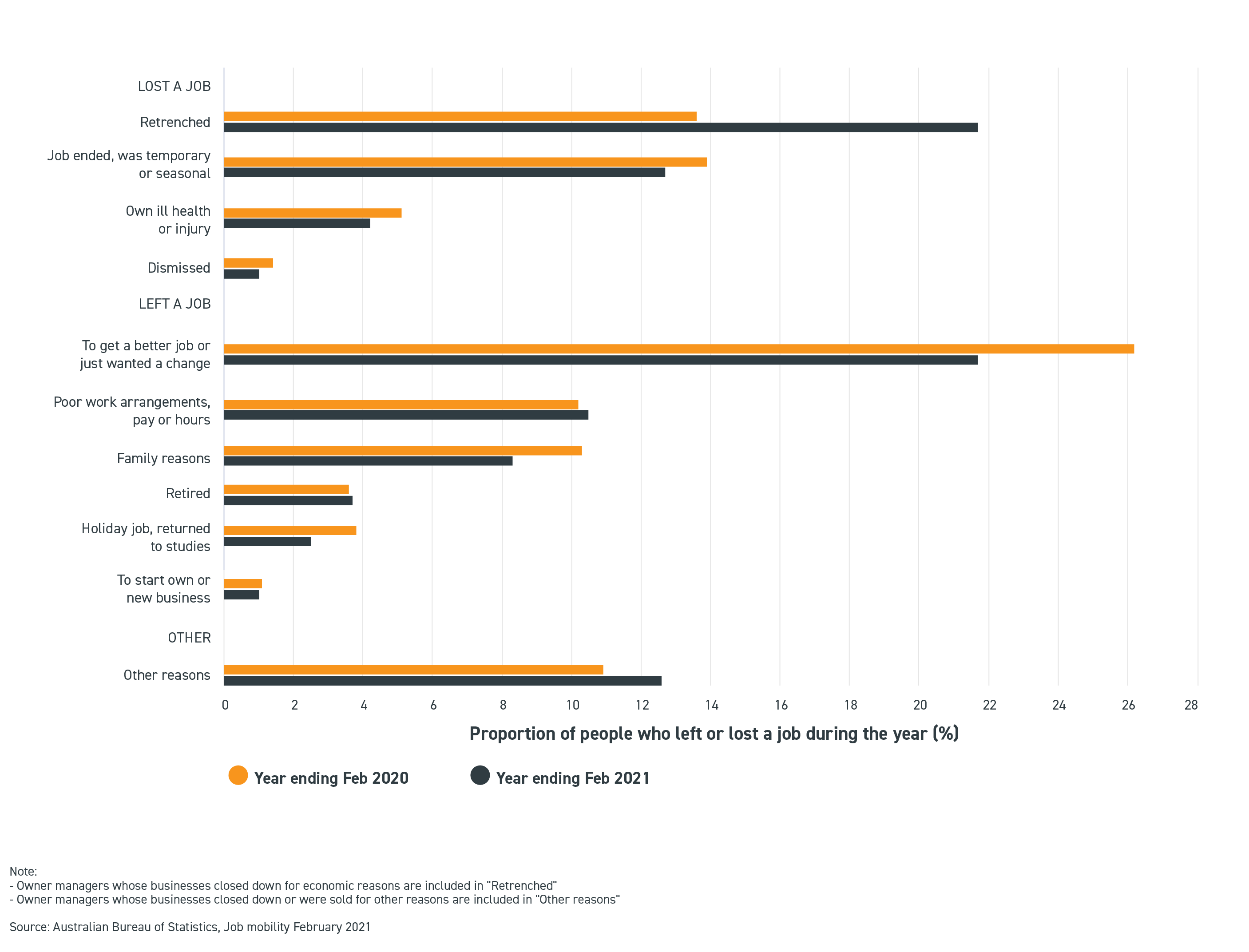Known as “The Great Resignation”, this new workplace phenomenon refers to the large number of workers expected to quit or voluntarily leave their jobs during and after COVID-19. Dr. Anthony Klotz, an Organisational Psychologist, came up with the term when he started seeing a trend of employees having “epiphanies” around how they viewed working, preferring remote work and placing more value in leading a life not dictated by the traditional 9-5 work aesthetic.
This blog will address what started this trend, the statistics surrounding “The Great Resignation” and how it will affect businesses in 2022.
“The Great Resignation”: where did it start?
Back in May 2021, while on an interview with Bloomberg, Dr. Anthony Klotz explained the four reasons he believes started the concept of “The Great Resignation”:
- A backlog of resignations: those workers who considered resigning from their positions prior to the start of COVID-19 were suddenly shocked into staying due to the uncertainties surrounding the pandemic. However, employees are used to remote work models and how “things work” now, so the desire to resign, retire or find alternative work has returned.
- Employee burnout: workers who had to juggle at-home parenting, working in highly stressful environments during the pandemic such as healthcare, ended up being pushed to the edge. With travel on hold, these employees found themselves saving more money and the concept of resignation was the break they needed.
- Work-life value: once employees had adjusted to remote work practices, many started having “epiphanies” around their own personal lives and where work fits in. They started re-assessing whether their current jobs were as fulfilling and if they felt appreciated. Those who concluded they weren't, looked to resign and perhaps find alternative work where they felt more valued.
- Working from home: remote work became the norm for a lot of people, so when businesses started asking them to return home full-time (whether that was because of the type of work or a business-wide mandate) many wanted to remain working from home and said no.
In Australia, total job vacancies at the end of September 2021, sat at around 333,700, while in America, at the end of November 2021, 10.6 million job openings remained. The labour shortage has given workers the power to request wages that suit them and are now seeking jobs with businesses that can offer more, not just a “join an industry-leader” tagline.
“The Great Resignation” facts
When looking at the Australian market, “The Great Resignation” isn’t as prominent as it is in America. Instead, while employees are resigning from jobs, they are simply finding better opportunities in others. Think “job-hopping”. In fact, the most recent statistics from the Australian Bureau of Statistics state that at the end of February 2021, 1.8 million Australians left or lost their job. Of those that left their jobs,10.5% were because of poor working hours or pay and 21.7% did so to get a better job or just wanted a change. LinkedIn shared figures that showed a 26% jump in workers changing employers in October 2021 compared with the same time in 2019.

This isn’t to say that “The Great Resignation” has avoided Australian shores altogether. Gartner’s Behavioural Scientist, Aaron McEwan, anticipates the arrival of this trend as early as March 2022 in Australia, where it will be a “movement of talent we will be unprepared for". While Australia’s job market gained back some confidence during the pandemic, with our Australian public debt ratio expected to hit 43% of GDP by the end of 2022, McEwan points out that “people may not get bonuses that are as good as they hoped or be properly thanked in performance reviews for their recent hard work” which could spur “The Great Resignation” into action.
In America, the latest statistics released by the Bureau of Labor Statistics prove Dr. Klotz’s predictions are starting to come full-circle in The States. In November 2021, the number of Americans who quit their job hit a series high of 4.5 million, increasing the quit rate to 3%. In October 2021, for comparison, this figure was 8.9% lower.
In Europe, “The Great Resignation” concept of employees starting to rethink their relationship towards work is prominent amongst the younger generation. YPulse’s “What’s next for work” trend report showed 20% of millennials in Western Europe quit their jobs in 2021. Of that 20%, the top reasons included a better financial offer elsewhere (20%), their previous job was bad for their mental health (19%) or a promotional opportunity elsewhere (17%). 15% stated that the jobs they left behind had poor work-life balances, while an equal 13% left because they weren’t passionate about their jobs, didn’t get along with their employers and wanted more flexible working hours.
Unless businesses start to improve employee retention and spark the conversation around what employees want to see or what benefits they would like to receive, "The Great Resignation" is at risk of putting people out of business.
Predictions for 2022 and ways to survive “The Great Resignation”
So, what workplace trends are expected in 2022 as a result of this “mass quit” phenomenon? Here are four trends to expect:
Flexible work practices
The pandemic has instilled within employees the desire for more flexible work arrangements. These requests have developed throughout the pandemic to evolve from a half-day on Friday to allowing employees to work anywhere and anytime, should their job role functions allow it. Instead of stating work hours to be the usual 38-40 hour working week starting at 9 a.m. with a 1-hour lunch break, employees want a shift to focus on deliverables and when they work. This way, workers can coordinate personal activities around work requirements: "let me know what you want delivered and when it is to be delivered and I'll make sure it is done."
Hybrid work arrangements
Hybrid work models involve adjusting work locations (in office and working from home) as necessary for each worker's job requirements. And managers are being made responsible for assessing their teams and customising hybrid-work arrangements that work for each individual. Instead of business-wide mandates stating all employees work-from-home or in the office, managers know their team needs better and should be allowed to adjust work locations for employees as they see fit.
Face-to-face communication substitutions
According to organisational behavioural research, face-to-face communication will always trump virtual communication. When a situation is complex, face-to-face communication is key to build trust within collaborative settings. If a business, for example, is anticipating the continuation of working from home requirements, then investments in HR-tech, such as engagement and job satisfaction surveys, are a must. Employees who may be completely virtual, because of remote work or because they are offshore employees, will benefit from technology that allows them to get to know each other better more efficiently, like Zoom or Microsoft Teams.
Behavioural telemedicine is on the rise
The increased transparency in having nonjudgmental conversations about mental health is one of the few positives to come from the pandemic. Change can cause people to experience poor mental health symptoms and with many medical facilities closed, telemedicine found its niche. Businesses have begun offering telemedicine options to their employees, such as free virtual psychologist appointments or even hiring their own virtual psychologist services for their company.
One way to combat labour shortages: Outsourcing
With labour shortages gripping economies worldwide, organisations should consider alternative resourcing strategies, like outsourcing, to fill open vacancies. As it gets harder and harder to find quality candidates, outsourcing allows businesses to access a larger, global talent pool. With the influx of virtual communication tools and remote work guides available, it’s becoming easier for businesses to facilitate an efficient outsourcing component for their business.
To demonstrate how outsourcing to the Philippines became the solution to overcoming individually unique business challenges, we have created an eBook with 12 in-depth, real-life client success stories across a variety of industries like accounting, business services, financial services, technology and real estate.














































.jpg?width=299&height=196&name=Mega%20Menu_FAQs%20(1).jpg)








